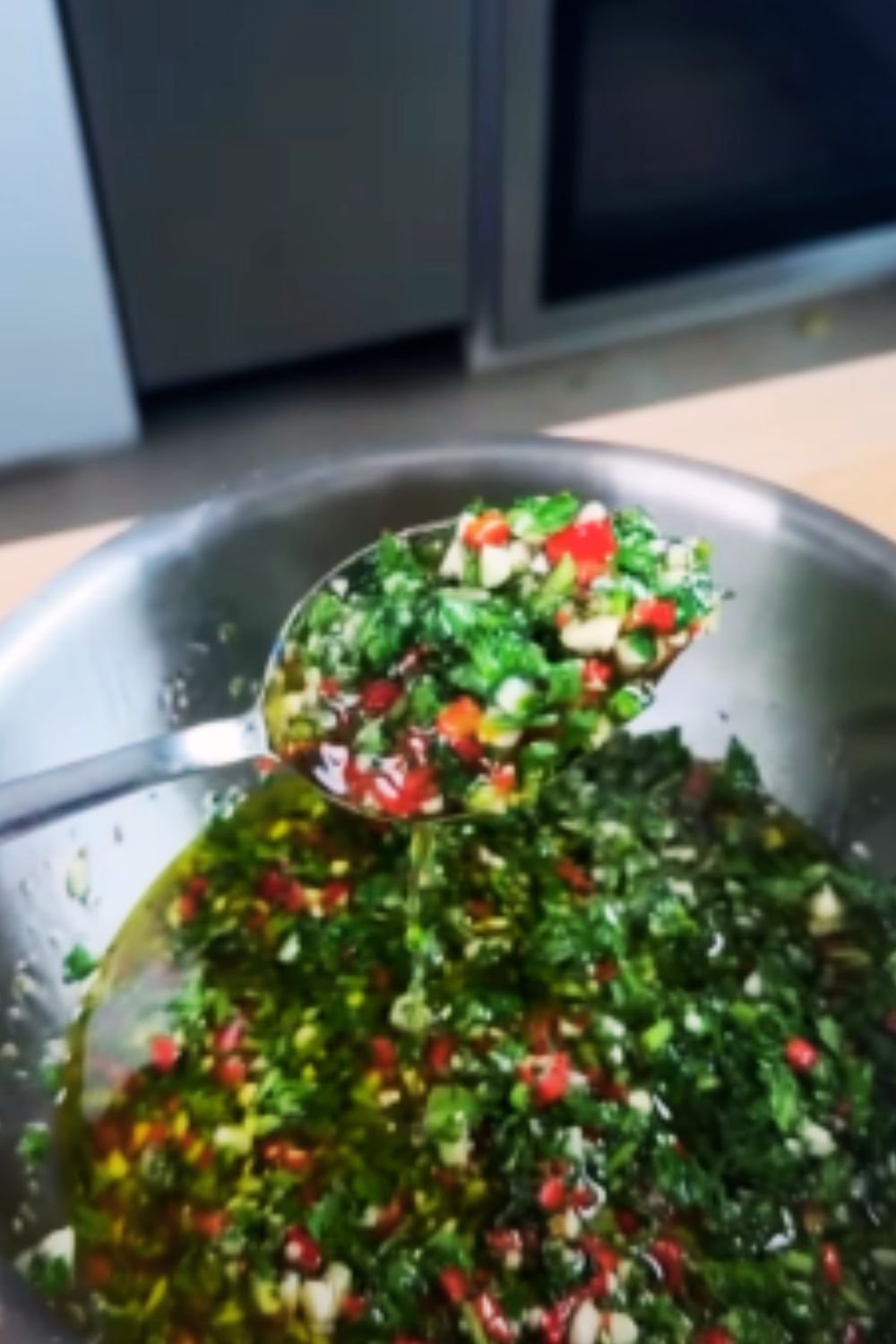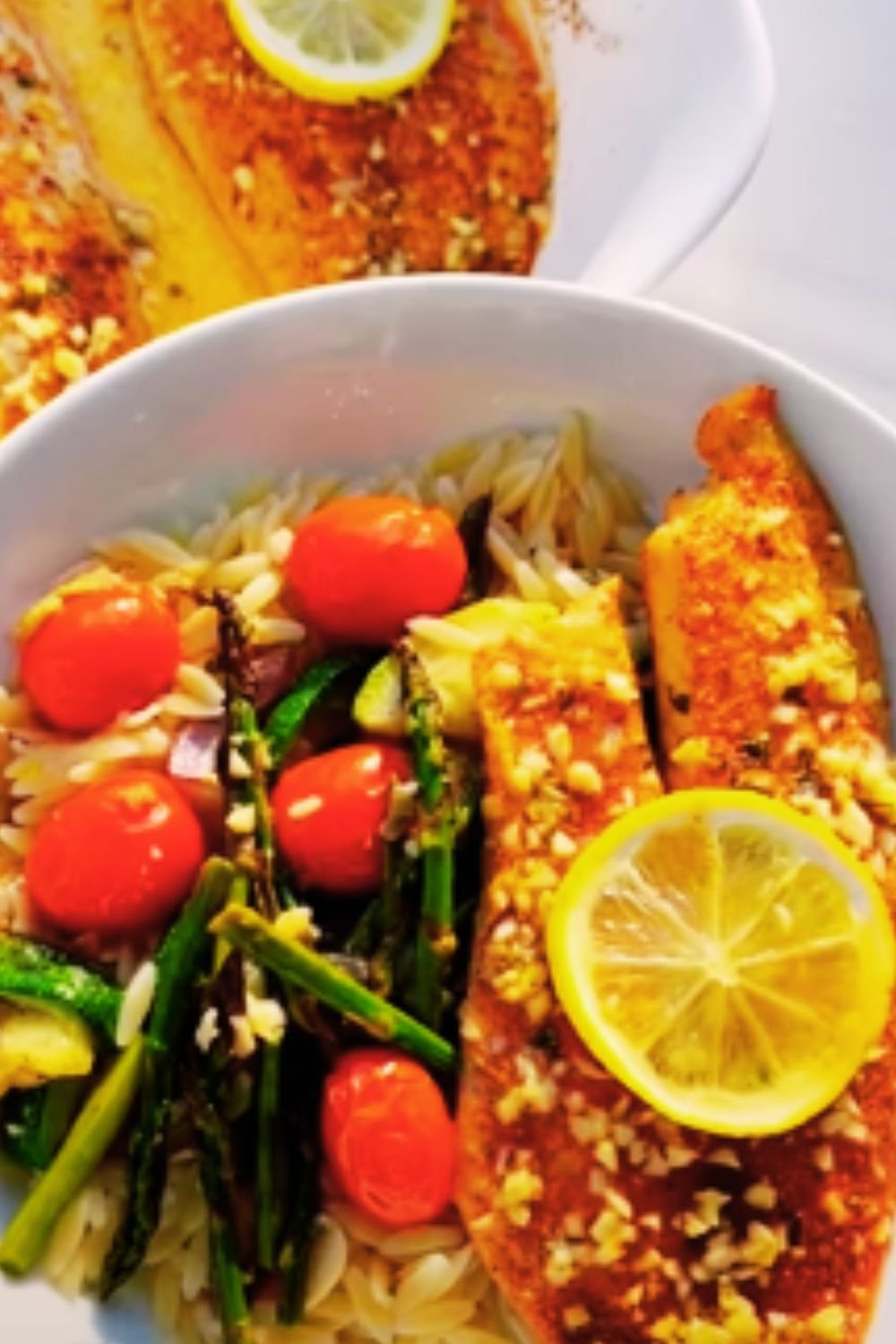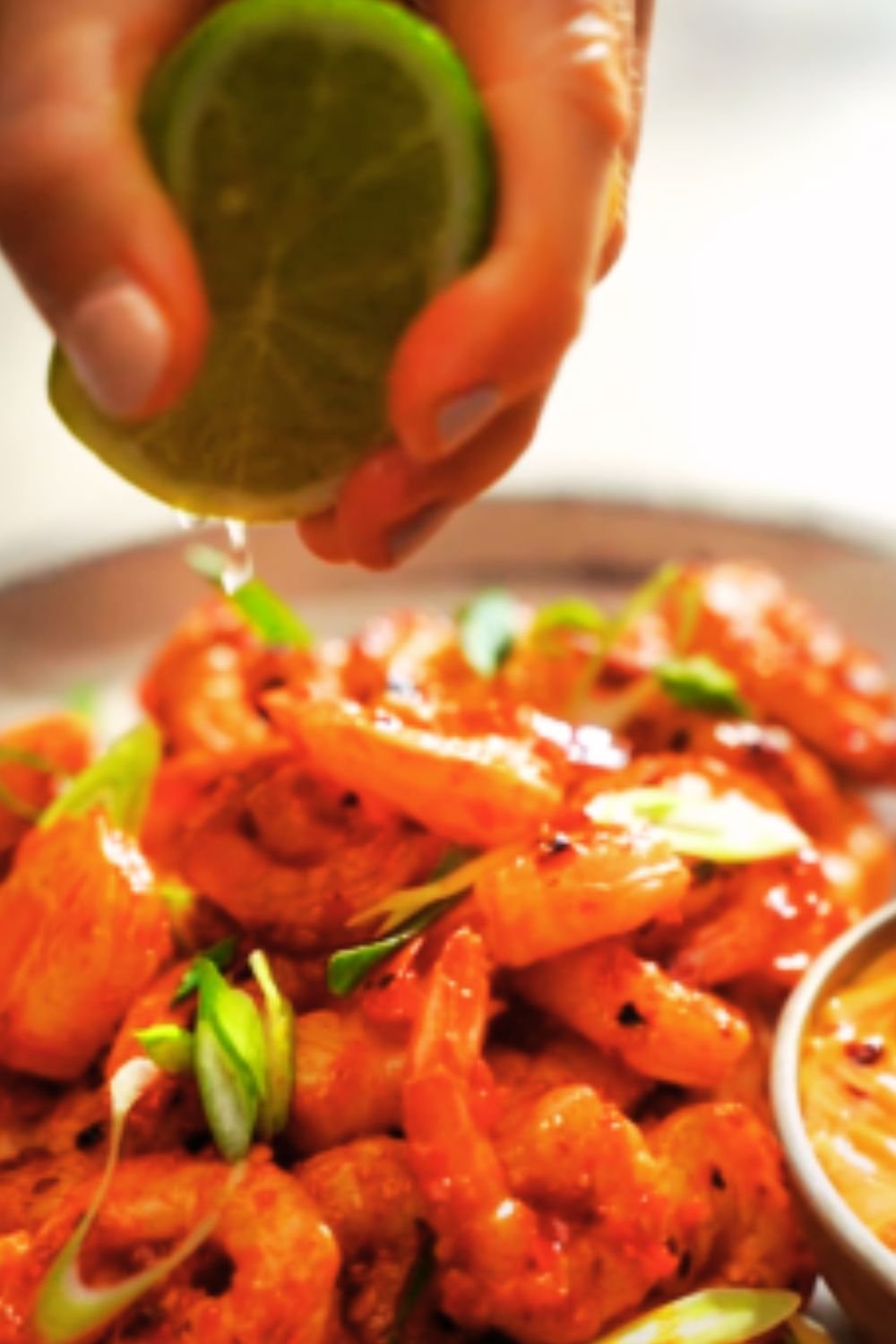Have you ever tasted a sauce so vibrant and flavorful that it completely transforms an ordinary dish into something extraordinary? That’s exactly what chimichurri does. As someone who’s spent years perfecting various recipes in my kitchen, I can confidently say that chimichurri sauce holds a special place in my culinary arsenal.
Chimichurri originates from Argentina and Uruguay, where it’s considered the go-to condiment for their famous grilled meats. But don’t be fooled by its humble appearance – this uncooked sauce packs a punch of fresh herbs, tangy vinegar, and aromatic garlic that can elevate practically any meal.
Today, I’m sharing my tried-and-true chimichurri recipe that I’ve refined over countless family gatherings and dinner parties. Whether you’re a seasoned chef or a cooking novice, this recipe is foolproof and guaranteed to impress.
What is Chimichurri?
Before diving into the recipe, let’s understand what makes chimichurri so special.
Chimichurri is an uncooked sauce made primarily from finely chopped parsley, minced garlic, olive oil, vinegar, and red pepper flakes. There are two main versions:
- Green chimichurri (chimichurri verde): The classic version we’re making today, featuring fresh herbs and a vibrant green color.
- Red chimichurri (chimichurri rojo): A variation that includes tomatoes and red bell peppers.
What makes chimichurri unique is its perfect balance of flavors – herbaceous, tangy, garlicky, with just the right amount of heat. Unlike many other sauces, chimichurri is meant to be served at room temperature, allowing all the flavors to meld together perfectly.
The History Behind Chimichurri
The origins of chimichurri are as flavorful as the sauce itself. While there are several theories about how the sauce got its name, the most popular one suggests that it comes from “Jimmy McCurry,” a British meat trader who created the sauce. Over time, his name was allegedly modified to “chimichurri” as locals found it difficult to pronounce.
Another theory claims the name derives from the Basque term “tximitxurri,” meaning “a mixture of several things in no particular order.”
Regardless of its name origin, chimichurri has been a staple in Argentinian cuisine for generations, traditionally paired with their famous asado (barbecued meat). Today, it has gained international popularity, finding its way into kitchens worldwide.
Essential Ingredients for Authentic Chimichurri
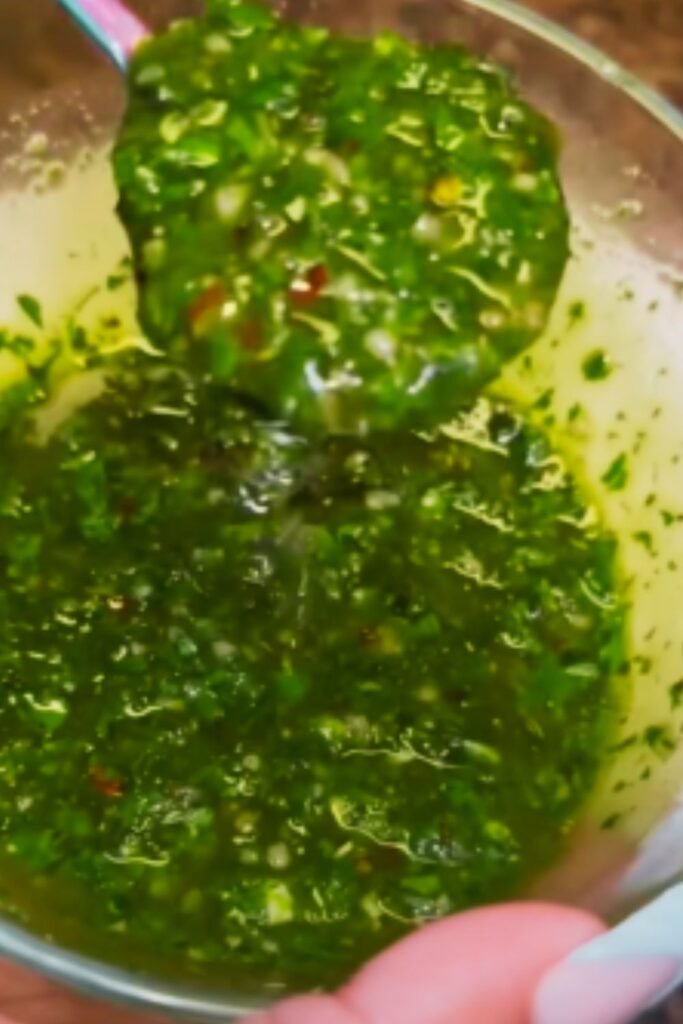
The beauty of chimichurri lies in its simplicity and the quality of its ingredients. Here’s what you’ll need:
Primary Ingredients
- Fresh parsley: The foundation of traditional chimichurri. Always use flat-leaf (Italian) parsley, not curly parsley, for the best flavor.
- Fresh oregano: Provides an earthy, aromatic quality. You can substitute dried oregano if fresh isn’t available.
- Garlic: Adds pungency and depth. Fresh garlic is non-negotiable here!
- Red wine vinegar: Contributes acidity and brightness.
- Extra virgin olive oil: The better the quality, the better your chimichurri.
- Red pepper flakes: For a touch of heat.
- Salt and pepper: To balance all the flavors.
Optional Add-ins
While purists might stick to the basic recipe, these additions can create interesting variations:
- Fresh cilantro: For a more complex herbal flavor profile.
- Red bell pepper: Adds sweetness and body.
- Shallot or red onion: Provides a mild onion flavor.
- Lemon juice: Can be used alongside or instead of vinegar for a different acidity.
- Paprika: Especially smoked paprika can add depth.
- Cumin: A pinch adds warmth and earthiness.
Traditional Chimichurri Recipe
Here’s my authentic chimichurri recipe that stays true to its Argentinian roots:
Ingredients
- 1 cup firmly packed fresh flat-leaf parsley leaves
- 4 medium garlic cloves, peeled
- 2 tablespoons fresh oregano leaves (or 2 teaspoons dried oregano)
- 1/2 cup extra virgin olive oil
- 2 tablespoons red wine vinegar
- 1 teaspoon sea salt
- 1/2 teaspoon freshly ground black pepper
- 1/2 teaspoon red pepper flakes (adjust to taste)
Equipment Needed
- Food processor or sharp knife
- Cutting board
- Measuring cups and spoons
- Glass jar or container with lid for storage
Step-by-Step Instructions
- Prepare the herbs: Wash the parsley and oregano thoroughly, then pat dry completely with paper towels. Remove thick stems from the parsley.
- Chop by hand method (traditional):
- Finely mince the garlic cloves
- Chop the parsley and oregano very finely
- In a bowl, combine the chopped herbs and minced garlic
- Add the olive oil, vinegar, salt, pepper, and red pepper flakes
- Stir to combine thoroughly
- Food processor method (quicker):
- Pulse the garlic in the food processor until finely minced
- Add the parsley and oregano, pulse until finely chopped (but not puréed)
- Transfer to a bowl and add the olive oil, vinegar, salt, pepper, and red pepper flakes
- Stir to combine
- Rest the sauce: Let the chimichurri sit at room temperature for at least 30 minutes before serving to allow the flavors to meld.
Chef’s Notes
- For the most authentic flavor, chop the ingredients by hand rather than using a food processor. Hand-chopping gives you more control over the texture.
- Make chimichurri at least a few hours before serving, ideally the day before. The flavor improves significantly as it rests.
- Never cook chimichurri – it’s meant to be served raw.
Chimichurri Variations
While I’m a fan of the classic recipe, here are some delicious variations that still honor the spirit of traditional chimichurri:
Red Chimichurri (Chimichurri Rojo)
To make this vibrant variant:
- Add 1 diced red bell pepper
- Include 1 small diced tomato
- Add 1/4 cup finely chopped red onion
- Increase red pepper flakes to 1 teaspoon
- Add 1 teaspoon smoked paprika
Cilantro Chimichurri
For those who love cilantro:
- Replace half the parsley with fresh cilantro
- Add the juice of half a lime
- Include 1/2 teaspoon ground cumin
Mediterranean Chimichurri
This fusion variation adds:
- 2 tablespoons of capers, rinsed and chopped
- Zest of one lemon
- 1 tablespoon lemon juice
- 1 anchovy fillet, minced (optional)
Nutritional Profile of Chimichurri
For those watching their nutrition, here’s a breakdown of what chimichurri offers:
| Nutrient | Amount per 2 Tbsp | Benefits |
|---|---|---|
| Calories | ~80 | Primarily from heart-healthy olive oil |
| Fat | ~9g | Mostly monounsaturated from olive oil |
| Carbohydrates | ~1g | Very low-carb friendly |
| Protein | ~0.5g | Not a significant protein source |
| Vitamin C | ~15% DV | From fresh parsley and oregano |
| Vitamin K | ~25% DV | Abundant in parsley |
| Vitamin A | ~6% DV | From herbs and red pepper |
| Iron | ~4% DV | Contributed by parsley |
Beyond the macronutrients, chimichurri is rich in antioxidants from the fresh herbs and garlic, which offer anti-inflammatory benefits. The raw garlic also provides allicin, a compound with potential antibacterial and heart-healthy properties.
Perfect Pairings: What to Serve with Chimichurri
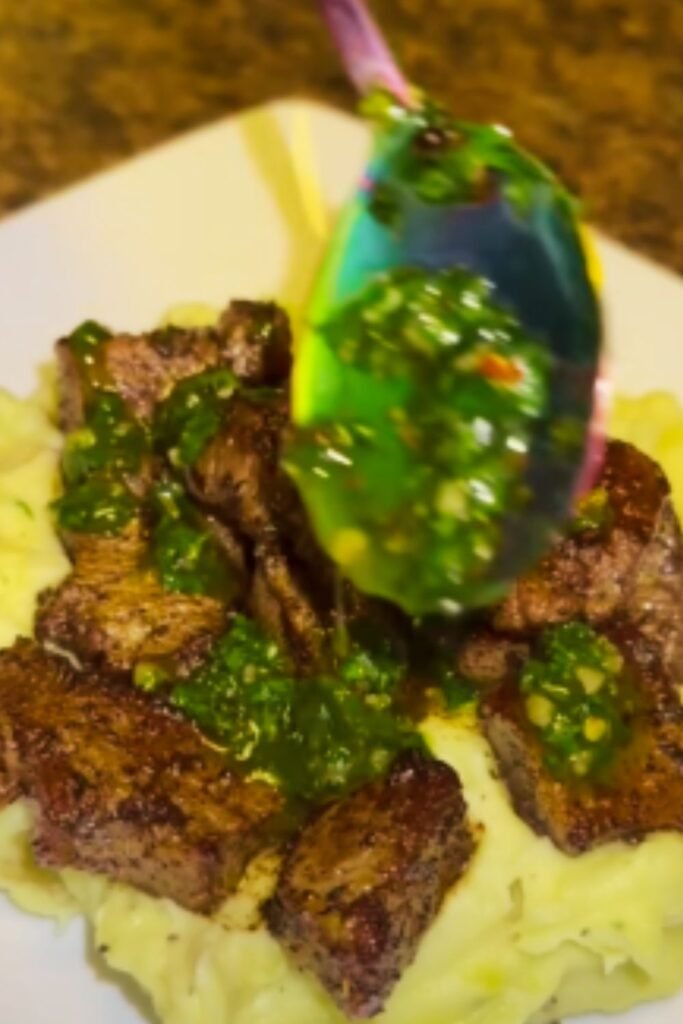
Chimichurri is incredibly versatile. Here are my favorite ways to use it:
Traditional Pairings
- Grilled meats: Especially skirt steak, flank steak, or ribeye
- Grilled chicken: Particularly chicken thighs
- Grilled chorizo or other sausages
- Grilled fish: Especially meaty varieties like swordfish or salmon
Creative Uses
- Roasted vegetables: Drizzled over roasted potatoes, carrots, or bell peppers
- Grain bowls: As a flavor-packed topping for quinoa or rice bowls
- Eggs: Amazing with scrambled eggs or an omelet
- Sandwiches: Use as a spread instead of mayonnaise
- Pizza: Drizzle over after baking for a fresh finish
- Pasta: Toss with warm pasta for a light, herb-forward sauce
- Dip: Served with crusty bread
Complete Meal Suggestions
- Argentinian feast: Grilled skirt steak, chimichurri, grilled bell peppers, and a simple green salad
- Weeknight dinner: Chimichurri chicken with roasted sweet potatoes and sautéed greens
- Vegetarian option: Grilled portobello mushrooms topped with chimichurri, served with a quinoa pilaf
Storage Tips and Shelf Life
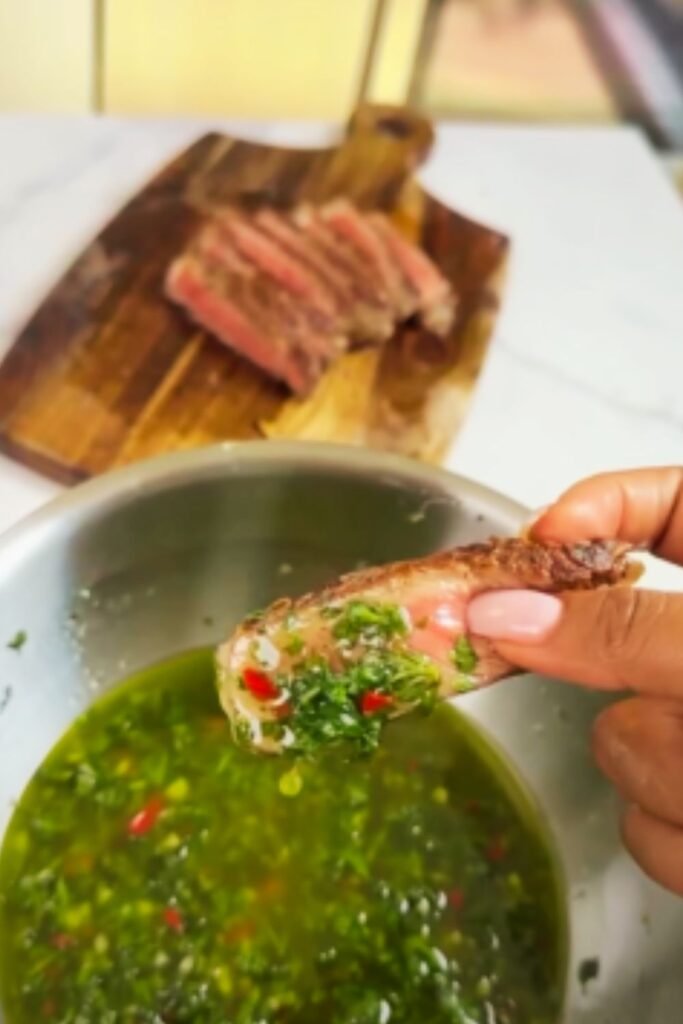
To keep your chimichurri fresh and flavorful:
Proper Storage
- Store in an airtight glass container in the refrigerator
- Pour a thin layer of olive oil on top to create a seal if storing for more than a day
- Let it come to room temperature before serving for the best flavor
Shelf Life Guide
| Storage Method | Duration | Quality Notes |
|---|---|---|
| Room temperature | 2-3 hours | Ideal for serving |
| Refrigerated (covered) | 1-2 weeks | Flavors intensify over first 24 hours |
| Frozen in ice cube trays | Up to 3 months | Good for cooking, less ideal for fresh applications |
Signs of Spoilage
Chimichurri has gone bad if you notice:
- A sour or off smell (beyond the normal vinegar tang)
- Discoloration beyond the natural darkening
- Mold growth
- Fizzing or bubbling
Troubleshooting Your Chimichurri
Even with a simple recipe, issues can arise. Here’s how to fix common problems:
Too Oily
- Add more chopped herbs and vinegar to balance
- Ensure you’re using the correct herb-to-oil ratio (roughly 1 cup herbs to 1/2 cup oil)
Too Acidic
- Add a bit more olive oil
- A tiny pinch of sugar can help balance excessive acidity
- Add more herbs
Too Salty
- Add more herbs and oil
- In extreme cases, add a small amount of water
Too Bland
- Let it rest longer (flavors develop over time)
- Add more garlic or red pepper flakes
- Check that your vinegar is good quality
- Add a pinch more salt
Herbs Turning Brown
- Ensure herbs are completely dry before chopping
- Use the freshest herbs possible
- Store with a thin layer of oil on top
- Chop just before mixing with other ingredients
The Cultural Significance of Chimichurri
In Argentina, chimichurri is more than just a condiment—it’s a cultural institution. No asado (barbecue) is complete without a bowl of chimichurri on the table. It represents the country’s rich culinary heritage and the influence of European immigrants who brought their herb-forward cooking traditions to South America.
In my travels through Argentina, I’ve noticed that every family has their version, often with recipes passed down through generations. Some are closely guarded secrets, while others are proudly shared with anyone who shows interest.
What I find most beautiful about chimichurri is how it brings people together. The communal nature of an Argentinian asado, with chimichurri as the centerpiece condiment, creates an atmosphere of sharing and connection that transcends the meal itself.
Making Chimichurri Your Own
While I’ve shared my favorite authentic recipe, I encourage you to experiment and make chimichurri your own. The basic formula (herbs + garlic + acid + oil) is infinitely adaptable.
Some variations to consider:
- Try different herb combinations
- Experiment with various acids (white wine vinegar, sherry vinegar, different citrus juices)
- Adjust the heat level to your preference
- Add unexpected ingredients that complement the basic profile
The best recipes evolve over time, influenced by personal taste and available ingredients. My current recipe is the result of years of tweaking and adjusting. Don’t be afraid to make it your own!
Frequently Asked Questions
Q: Can I make chimichurri ahead of time? Absolutely! In fact, chimichurri tastes better after it has had time to sit. Make it up to a day in advance for the best flavor.
Q: Why is my chimichurri bitter? Bitterness usually comes from using too many herb stems, especially parsley stems. Make sure to remove the thicker stems before chopping. Also, some olive oils can be naturally bitter, so choose a good quality, mild olive oil.
Q: Is chimichurri supposed to be spicy? Traditional chimichurri has a mild heat from red pepper flakes. You can adjust the amount based on your heat preference—authentic versions usually have a noticeable but not overwhelming heat.
Q: Can I freeze chimichurri? Yes! Freeze it in ice cube trays, then transfer the frozen cubes to a freezer bag. This works well for cooking applications, though fresh chimichurri is always superior for serving as a condiment.
Q: What can I substitute for red wine vinegar? White wine vinegar is the closest substitute. You can also use fresh lemon juice, though this will give a different flavor profile. Sherry vinegar is another excellent option.
Q: How long does chimichurri last in the refrigerator? Properly stored in an airtight container, chimichurri will last 1-2 weeks in the refrigerator. The flavors will change over time, becoming more mellow and integrated.
Q: Can I use a blender instead of chopping by hand? You can, but be very careful not to over-process. Pulse in very short bursts and stop while the herbs still have texture. Traditional chimichurri should have visible bits of herbs, not a smooth paste.
Q: Is chimichurri similar to pesto? While both are herb-based, green sauces, they’re quite different. Pesto uses basil as the primary herb, includes nuts and cheese, and has a creamy texture. Chimichurri is herb-forward with a vinegar tang and no nuts or cheese.
Final Thoughts
Chimichurri is one of those magical condiments that transforms ordinary ingredients into extraordinary meals. Its vibrant flavors, simple preparation, and versatility make it a must-have in any home cook’s repertoire.
What I love most about chimichurri is how it connects us to culinary traditions that span continents and generations. Every time I make it, I’m participating in a cooking practice that has brought joy to countless tables throughout history.
Whether you’re grilling steaks for a special occasion or looking to brighten up your weekday vegetables, chimichurri brings a burst of fresh, herbaceous flavor that few other condiments can match.
I hope you’ll try this recipe and experience the joy of fresh chimichurri. And remember, cooking is about making something that tastes good to you – don’t be afraid to adjust and experiment until you find your perfect version!
